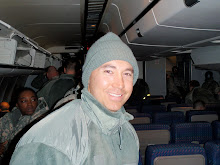

This gentleman was injured in an IED (road-side bomb) blast. He was transfered to us in the middle of the night. The story I got was that he had some broken ribs and missing teeth. When he arrived, the ANA physician stated in broken english that he had 2 chest tubes, was on the ventilator and had no blood pressure. We were able to resuscitate him and for the first time in this hospital, started vasopressors (which he had to mix ourselves. Since I have never actually mixed it up myself, I had to look it up in a book). It was a great case, especially since I was able to give a mini-lecture on vasopressors, indications, bad side effects, etc.. The patient actually did well for the next few days, and we were just waiting for him to wake up so we could extubate him. Well.....that morning on rounds, I happened to comment about the chest tube, and asked if it was high. I am embarrassed to say, I have very little experience with chest tubes management and do not recall ever putting one in. The surgeons said yes and that they would pull it back a bit. That was HUGE mistake. The next morning I come in and the patient is on pressors, had been bolused 2L of fluids and is hypoxic (not oxygenating well) on 100% O2. I get worried and asked the overnight doc what he did, which was nothing except try to treat his low blood pressure and hypoxia, but did nothing to try to find out why. I tell them to get a chest xray now and the bottom CXR comes back first ( do not know why it loaded the pics in reverse order). I tell them I think he has pneumothorax, and that this radiograph is called the "deep sulcus sign". I had seen this once during a medical jeopardy morning report my first or second year. I wasn't exactly sure, but I was fairly certain. What happens is, when the patient lies on their back, instead of the air rising to the top of the chest and pushing the lung towards the middle of the chest, the air rises to the top and pushes the lung downward, but the lung markings go all the way out to the chest wall on an AP view so you can get fooled. You would have to take a lateral view to see the smooshing of the lung. But, what you do get is pushing down of the diaphragm, thus called the "deep sulcus sign". The reason this patient developed the pneumothroax (actually tension pneumothorax) was because when they pulled back the chest tube, the proximal port was no longer inside the chest wall and instead between the tissue, causing in essence an air leak. The top CXR is after insertion of the new chest tube. As you can see the tension pneumothorax is worse. Again because the proximal port is not inside the chest wall. You can also see abundant air between the skin and muscle, which shows up as black between 2 white stripes. Needless to say this patient died around 5PM that day, (the patient was practically coding hours before I stepped in the door, and we resuscitated him no less than 5 times in a 6 hour time period) . It was a hard lesson to learn, but I actually got about 20+ people to attend the mortality conference on this patient (the most that has ever attended). We discussed this xray finding, chest tube management (something I did not know too much about prior to this), and the need to diagnose and not just treat symptoms.









